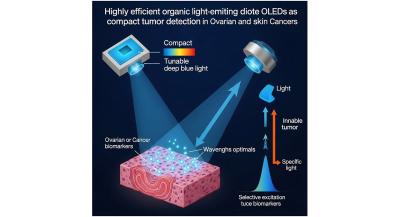Researchers from India’s Noida Institute of Engineering and Technology and Gautam Buddha University have developed a novel approach for the early detection of skin and ovarian cancer based on photodynamic detection (PDD), utilizing TADF OLED emitters.
The researchers explain that OLEDs are suitable for building PDD devices as they offer high mechanical flexibility, wavelength specificity, low operating volume and facile integration into wearables and endoscopic devices.
The researchers developed their own OLED device stack, based on doped carbazole-based TADF OLED OLED emitters, and have achieved an EQE of 9%, brightness of 6,192 cd/m2 and power efficiency of 26.7 lm/W, and the device proved to offer accurate and precise biomarkers for the detection of non-invasive cancers.
The researchers explain that a healthy person can be distinguished from an ovarian cancer patient based on the shifter fluorescence produced by their urine and from a skin cancer patient based on the fluorescence transmitted through the skin.
